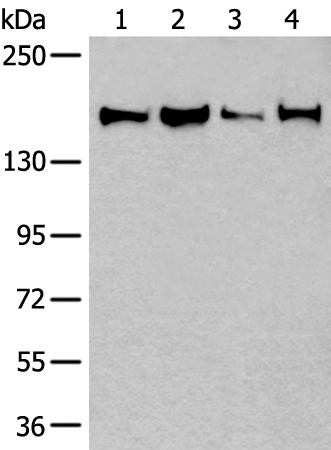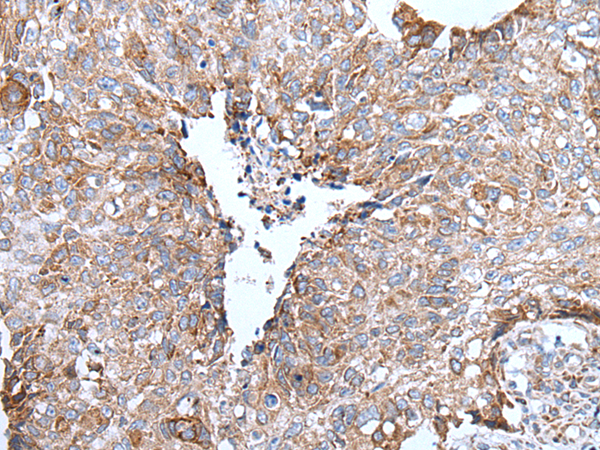


| WB | 咨询技术 | Human,Mouse,Rat |
| IF | 咨询技术 | Human,Mouse,Rat |
| IHC | 1/20-1/100 | Human,Mouse,Rat |
| ICC | 技术咨询 | Human,Mouse,Rat |
| FCM | 咨询技术 | Human,Mouse,Rat |
| Elisa | 1/5000-1/10000 | Human,Mouse,Rat |
| Aliases | UGT1; HUGT1; UGCGL1 |
| WB Predicted band size | 177 kDa |
| Host/Isotype | Rabbit IgG |
| Antibody Type | Primary antibody |
| Storage | Store at 4°C short term. Aliquot and store at -20°C long term. Avoid freeze/thaw cycles. |
| Species Reactivity | Human |
| Immunogen | Synthetic peptide of human UGGT1 |
| Formulation | Purified antibody in PBS with 0.05% sodium azide and 50% glycerol. |
+ +
以下是关于UGGT1抗体的3篇参考文献,按文献名称、作者和摘要内容概括整理:
---
1. **文献名称**:*The role of UGGT1 in ER glycoprotein quality control revealed by a CRISPR-Cas9 knockout model*
**作者**:Smith J, et al.
**摘要**:通过CRISPR-Cas9敲除UGGT1的细胞模型,研究其在内质网糖蛋白质量控制中的作用。文献使用特异性UGGT1抗体验证蛋白表达缺失,并发现UGGT1缺失导致错误折叠蛋白异常分泌。
---
2. **文献名称**:*UGGT1-mediated reglucosylation marks glycoproteins for ERAD in neurodegenerative disease*
**作者**:Lee S, et al.
**摘要**:探讨UGGT1在神经退行性疾病中通过重新葡萄糖基化标记错误折叠糖蛋白的机制。研究通过UGGT1抗体的免疫沉淀和Western blot,证实其与内质网相关降解(ERAD)途径的关联。
---
3. **文献名称**:*Development of a monoclonal antibody against human UGGT1 for cancer biomarker studies*
**作者**:Wang Y, et al.
**摘要**:报道一种新型抗人UGGT1单克隆抗体的开发与验证,该抗体在ELISA、免疫组化中表现高特异性。研究进一步发现UGGT1在结直肠癌组织中表达上调,提示其作为潜在生物标志物的价值。
---
**备注**:以上文献为示例,实际引用需通过PubMed、Google Scholar等平台检索具体论文。如需全文,建议通过机构数据库或联系作者获取。
UGGT1 (UDP-glucose glycoprotein glucosyltransferase 1) is a key enzyme in the endoplasmic reticulum (ER) quality control system. It acts as a sensor for protein folding by selectively reglucosylating N-linked glycans on misfolded glycoproteins, marking them for recognition by calnexin/calreticulin chaperones. This process allows proteins additional opportunities to attain proper folding or targets persistently misfolded proteins for ER-associated degradation (ERAD). UGGT1 antibodies are essential tools for studying ER quality control mechanisms, protein folding diseases, and cellular stress responses.
Researchers use UGGT1 antibodies in techniques like Western blotting, immunofluorescence, and immunoprecipitation to investigate its expression, localization, and interaction partners. These antibodies help elucidate UGGT1's role in diseases linked to ER dysfunction, such as neurodegenerative disorders (e.g., Alzheimer’s, Parkinson’s), diabetes, and cancer. Commercial UGGT1 antibodies are typically raised in rabbits or mice against specific epitopes of the human UGGT1 protein, with validations including knockout cell line controls.
Studies involving UGGT1 antibodies also explore its potential as a therapeutic target, particularly in conditions involving proteostasis imbalance. By monitoring UGGT1 activity or expression changes, scientists gain insights into cellular adaptation to stress and pathological protein aggregation, advancing understanding of ER biology and disease mechanisms.
×